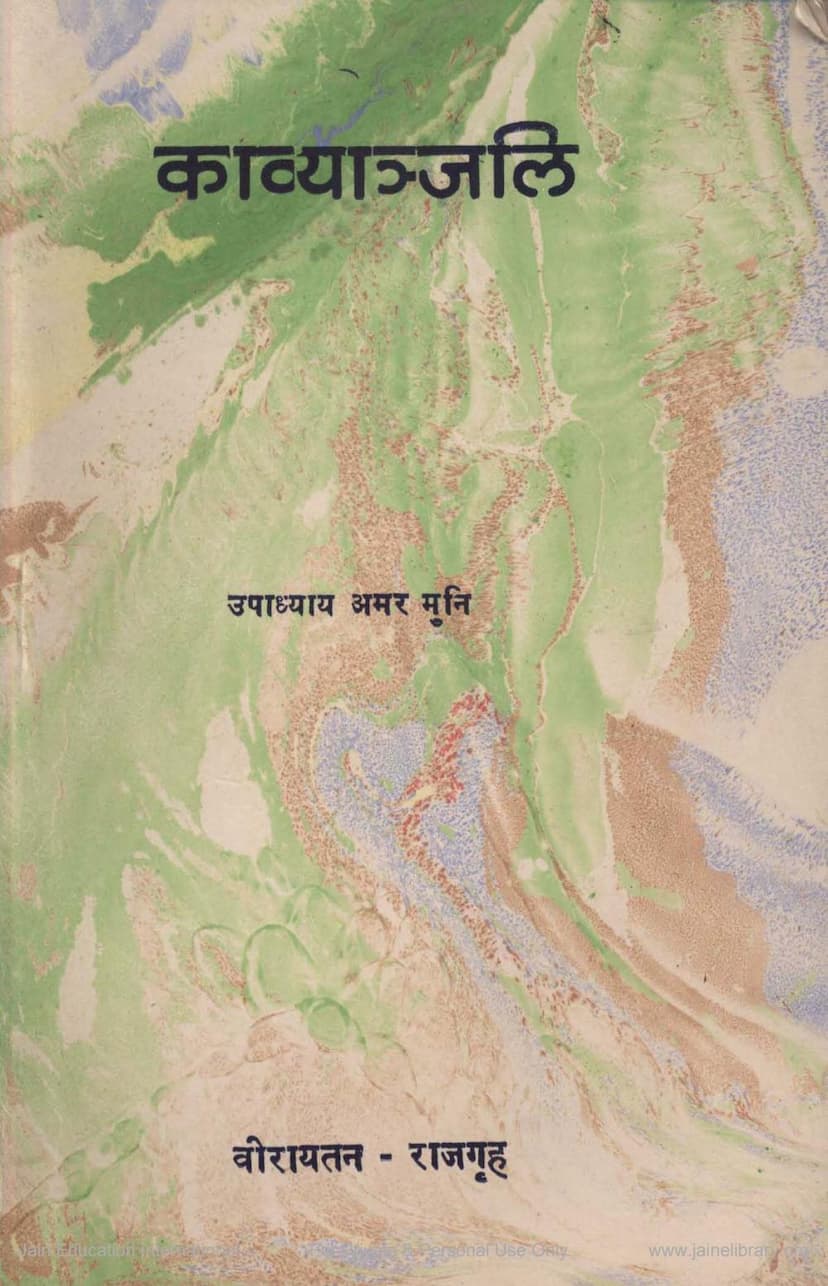Kavyanjali
Added to library: September 2, 2025

Summary
Here's a comprehensive summary of the Jain text "Kavyanjali" by Upadhyay Amarmuni, based on the provided pages:
Book Title: Kavyanjali (A Garland of Poetry) Author: Upadhyay Amarmuni Publisher: Sanmati Gyan Pith, Agra Edition: Second, December 22, 1989
Overall Theme and Purpose:
"Kavyanjali" is a collection of poems and verses by Upadhyay Amarmuni, a renowned Jain scholar, thinker, philosopher, writer, and orator. The book aims to present the realities of life and guide people towards the right path in accordance with the times. The poems are characterized by a blend of spiritual depth, philosophical insights, societal commentary, and emotional resonance. Amarmuni's poetry reflects a compassionate heart that empathizes with the joys and sorrows of humanity.
Key Themes and Content Across the Poems:
-
Humanity and Compassion:
- Paropkar (Altruism): The book strongly emphasizes the importance of selfless service and helping others. Poems like "Paropkar" highlight how trees, which provide shade, shelter, and sustenance, are superior to humans who lack compassion.
- Empathy for the Downtrodden: The verses vividly portray the suffering of the poor, the oppressed, and those in need. There's a call to extend a helping hand and consider them as one's own kin.
- Rejection of Discrimination: The poems advocate for universal brotherhood and condemn social discrimination, especially against those referred to as "Shudras" (outcastes). Amarmuni stresses that true human worth lies in actions, not birth.
-
Spiritual and Philosophical Teachings:
- The Value of Human Life: The poems repeatedly stress the preciousness and uniqueness of human birth ("Amulya Nar-Jeevan"), urging readers to use this life for the welfare of the world.
- Detachment and Non-Attachment: There's a strong emphasis on detachment from worldly possessions and ego ("Mat Vaibhav Ka Kuch Garv Karo"). The ephemeral nature of life and the illusionary nature of worldly pleasures are frequently mentioned.
- The Nature of Virtue and Vice: Poems like "Doshdrishti" and "Khal" use analogies from nature to illustrate how some people are drawn to negativity and flaws, ignoring goodness. The ideal "Nar-Ratna" (jewel among men) is described as someone with a virtuous mind, speech, hands, and feet.
- The Path of Righteousness: The verses encourage living a life of truth, righteousness, and spiritual pursuit, even in the face of adversity. References to figures like Harishchandra symbolize unwavering commitment to truth.
- Anekantavada (Non-Absolutism): The concept of "Anekant Drishti" is beautifully illustrated by showing how seemingly contradictory things (like water being both life-giving and destructive) exist in the world, implying that reality is multifaceted and judgments should be made with broader perspective.
-
Social Commentary and Reform:
- Critique of Societal Ills: Amarmuni addresses contemporary social issues like child marriage ("Shishu Ka Apna Parichay," "Paap Ki Ghatayen"), the plight of widows, and the hypocrisy in religious practices.
- The Call for Progress and Renaissance: Poems like "Swarnim-Rekha" and the preface by Tansuakhraj Daga suggest a period of renaissance and reformation, encouraging readers to move forward with the times.
- Critique of Superficiality: The book criticizes those who prioritize outward appearances or shallow pursuits over inner substance and selfless action.
- The Importance of True Sadhus and Propagators: Amarmuni sets an ideal for Jain monks and religious propagators, emphasizing their role in the welfare of both themselves and the nation.
-
Devotional and Inspirational Content:
- Praise of Lord Mahavir: The collection includes verses dedicated to Lord Mahavir, extolling his virtues as a giver of peace and knowledge.
- Prayers and Supplications: The book contains several "Prashasta-Prarthana" (Exalted Prayers) seeking divine grace for knowledge, compassion, righteousness, and liberation.
- Inspirational Metaphors: The "Deepak" (lamp) is used as a metaphor for self-sacrifice and enlightenment, inspiring readers to illuminate the world through their actions.
- The Ideal Listener and Devotee: The concept of a "Shreshth Shrota" (excellent listener) who absorbs teachings and acts upon them is presented, along with the essence of true devotion.
Literary Style and Tone:
- Accessible Language: While profound in thought, Amarmuni uses clear, accessible Hindi.
- Emotional Depth: The poems convey a wide range of emotions, from deep compassion and sorrow to fervent inspiration and devotion.
- Figurative Language: The use of analogies, metaphors, and allegories from nature and daily life makes the verses relatable and impactful.
- Direct Address: Many poems directly address the reader or a particular subject, creating a sense of personal engagement.
- Reformist Zeal: There is an underlying tone of reform and a desire to uplift society from its shortcomings.
Key Takeaways for the Reader:
"Kavyanjali" serves as a guide for righteous living, emphasizing the interconnectedness of humanity, the importance of spiritual growth, and the need for societal progress. It encourages readers to cultivate compassion, detachment, truthfulness, and selfless service, thereby leading a meaningful and purposeful life that contributes to the welfare of all beings. The collection is a testament to Amarmuni's profound understanding of human nature and his ardent desire to guide humanity towards a better future.